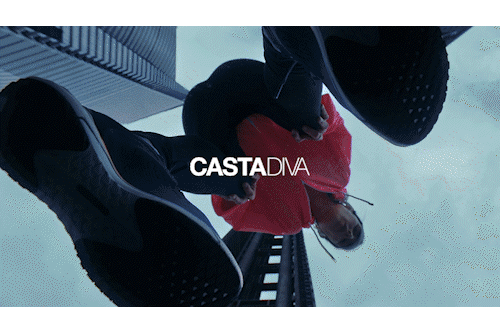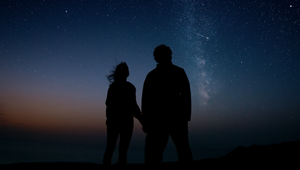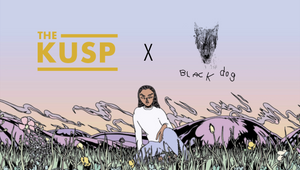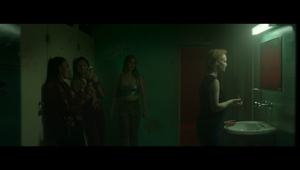
Independent and Inspired: The Creatives Taking London by Storm

LBB’s Uprising channel is brought to you in partnership with Ridley Scott Creative Group, in ongoing efforts to facilitate opportunities for the next generation of creative talent.
The Uprising channel amplifies the voices of emerging talent in the industry, and with the support of Ridley Scott Creative Group, the industry’s top talent will have an even louder voice on LBB’s global platform. The channel is an opportunity for up-and-coming talent to be celebrated for their artistry, personality, and inspirations, with each feature exploring their creative background, niche craft obsessions, the work they are most proud of, and views on the state of the industry.
London has always been, and will remain for the foreseeable future, one of the knots of the creative world. No matter where around the globe you work, you have come across London creatives, or you have become one yourself, even for a short amount of time. Yet, London comes with its challenges, especially today, and especially for recent graduates and juniors. It takes hard work and even harder inspiration to survive in one of the creative capitals of the world, but the reward in the end is so sweet for those that really want it. And when it comes to indies, here is where so many of them find their roots and, more increasingly than ever before, are met with success supported by new tech. Today, working for an indie comes with a whole new range of perks, especially for the wave of gen z creatives that are flooding the streets of the city - sustainability, ethics and meaningful work, all luring perspectives of the independent agency world.
We spoke to a few uprising creatives that are taking London by a storm - independent, inspired, and ready to change the industry.
Ellie Daghlian and Elisa Czerwenka
Uncommon
Creative Duo

How and when did you realise you wanted to be a creative?
Ellie> London Southbank, 2018. I was working as a copywriter for a slightly shady financial publisher, writing 10,000 word sales letters about cryptocurrencies which cOuLD ToTAlLy mAKe yOU a miLliOnAIre. Every day I trawled the internet for other jobs. Any other job. Until I saw one that was also a copywriter... but for Nike. For real?!?!? I was obsessed! I read advertising books every lunch break, gazed longingly into Ogilvy’s office every day (it was on my commute, don’t @ me), and eventually, won a scholarship to study at the School of Communication Arts 2.0. Fast forward five years and we just made a Nike Jordan ad. Gagged.
Elisa> I always loved drawing, painting, and playing music. I was obsessed with GIMP when I was nine, spent countless hours on Behance, looking through people’s portfolios, and designed ads for my school when I was 15. But, I didn’t know you could get paid for that. Then, in my final year of school, I was researching careers when I stumbled upon ‘art director’. Jackpot. It was exactly what I wanted to do. I printed it out and took it to my parents. They loved it (and were probably relieved that I wasn’t going to be a ;breadless; artist, as we say in German). Google said I had to go to London. So, I took off my skis, gave my last yodel, left Salzburg and headed straight for Elephant and Castle, to study at LCC, and later the SCA. I’ve been in London ever since. I feel so incredibly grateful that I get to do this job every day.
How did you get your start in the industry?
Ellie & Elisa> Ellie dressed up as a ferry and Elisa drew chihuahuas doing yoga and somehow that convinced Marc Lewis at the School of Communication Arts 2.0 to give us both places in a brutal but brilliant course that kept us going even through a global pandemic. When lockdown struck, Marc was one of the very first to swap to an online model, something he continues today for those not able to travel to London.
Thanks to the aforementioned pandemic, we graduated into the peak of an economic crisis. From our respective bedrooms, we searched desperately for placements as agency after agency promised they’d ‘probably be hiring again in six months’ time’.
Inspired by Marc, we looked outside of London, and decided to travel the world in virtual placements (we called it the Creative Rally: https://www.creative-rally.com/). All told, we did nine in a fortnight, stopping off at Colenso BBDO, TBWA Sao Paulo and Saatchi & Saatchi Japan, among others. It was an incredible experience and we learnt so much from so many different people, who were so generous with their time.
Afterwards, we did longer placements at Creature & BBC Creative, before finding our forever home at Uncommon.
What are some of the most significant projects you’ve worked on?
Most recently we launched ‘No Silence Please’, the latest iteration of ITV’s ‘Britain Get Talking’, supporting kids and guardians through exam stress.
Each execution borrows from the world of exams in a different way: the radio imitates those scratchy listening tapes, the press takes visual cues from exam papers, and the TV reimagines classic ‘Silence Please’ signs taped up on school doors.
The whole thing is gloriously anti design, complete with scanning imperfections in gritty black and white. We wanted none of it to feel or sound like a traditional ad. It’s meant to evoke conversation. It’s an incredible project to be a part of, encouraging conversation about the tough stuff, at a time when talking is more important than ever.
We also made a print campaign for British Airways’ Cityflyer, illustrating the speed of City Airport through distorted passports. We were lucky enough to work with the wonderful Emily Stein to shoot our models whilst blowing them in the face with 70 mph wind. That was a real ‘we get paid to do this??’ moment. Plus, we got to write a launch film for Nike Jordan. Thirty seconds of absurd, surreal, high-energy, hyper-real animation launching Jayson Tatum’s first signature shoe.
What does it mean to be a junior creative in London?
Elisa> It’s no Salzburg, that’s for sure. It’s big, noisy, tough and - gosh - it’s inspiring. I wouldn’t wanna be anywhere else. My walking speed has tripled. I can’t sit still. I have discovered passions I didn’t know I had. I feel so blessed to learn from the most incredible people around me. The talent here is insane, and not just in advertising. It’s all around you. You’ve just gotta soak it all up. People work hard to be here and you can feel it everywhere: in every corner shop, every station, every cafe, every gallery. I feel very lucky to be here.
Ellie & Elisa> But, it’s also an incredibly tough place, particularly if you’re not from here. It’s expensive. It’s mouldy. It’s a grind to get by. This is why we are so grateful to be doing this ridiculous job. We get to shoot models in the face with leaf blowers, build four tonne sculptures, work with incredible charities, etc. No two days look the same. It’s also why we want to help others break in, wherever they’re from, whatever their background. If you’re a young creative looking for advice, feel free to reach out.
India Penny
Wonderhood Studios
Creative

How and when did you realise you wanted to be a creative?
I always knew I wanted to do something creative: art was my superpower growing up. But, I’d be lying if I said being an advertising creative was my dream. I didn’t know it was even a job. It was more of a process of working out what I didn’t want to do, in order to work out what I did.
I started out trying to pursue a career as a freelance illustrator. It was only when I realised being a creative was all the things being an illustrator wasn’t that I knew it was the career for me! I’d get to think of my own ideas instead of just executing other people’s, I’d get to switch up the style of every campaign instead of keeping it the same for my whole career, and I’d get to spend all day chatting to a mate instead of the wall in my bedroom. I was instantly sold, but getting my foot in the door wasn’t so straightforward.
How did you get your start in the industry?
Luck and good timing. I met a man in a WeWork space who gave me the email of a creative team in London. I went down the next week with a backpack and my portfolio to meet them. They sold me the absolute dream, but at the same time, obliterated my illustration portfolio, describing my favourite poster as a ‘bird full of s**t’ and saying I’d have to start again. Advertising seemed like everything I wanted, but I couldn’t find a way to get there, so I resumed life in my bedroom as an illustrator. A year later covid-19 hit, the commissions died, and a sponsored Instagram ad popped up for a school called SCA. I racked my brain as to where I’d heard of it before and remembered the two creatives had mentioned it a year ago. So, I applied using all the intel they’d given me as ammo in my interview, got in, and was fortunate enough to get the money together to pay for it.
This is where I built a book with the support of some great mentors and met my fab creative partner Tad. Tad was my absolute rock through a year of gruelling placements after ad school. He also took some major hits for the team to get us hired at our dream of an agency, Wonderhood Studios (for which I am eternally grateful). He once travelled to a Harry Styles gig in Bologna dressed as a jar of Branston pickles while I filmed him and the Heathrow Airport during Storm Eunice to deliver a sandwich. Big up Tad.
What are some of the most significant projects you’ve worked on?
My favourite campaign I’ve worked on was the ‘The Sex-positive Hotline’ for IWD. This was an idea Tad and I had in our first presentation on placement at Wonderhood that actually got made (this never happens). In the briefing, there was a stat that during heterosexual sex, only 39% of cisgender women regularly orgasm (compared to 91% of cis men). So, we had the idea to create a sex hotline which helps close the orgasm gap by teaching callers how to make a woman orgasm. We got the sex icon, Megan Barton-Hanson to record it, littered Soho with posters to lure in creepy men, and got a surprising number of callers educated. The only hiccup was having to research orgasms with our screens on minimum brightness during our first week on placement.
A more recent campaign I’m proud to have been a part of was a PR stunt for Three X Samaritans. It was based on the insight that men talk about football much more than they do about their mental well-being. So, we created a campaign in collaboration with Chelsea F.C. At half-time, the Chelsea legends came out onto the pitch and lined up. But instead of having their usual numbers on their backs, they spelt out the Samaritans hotline number to encourage fans to ‘#TalkMoreThanFootball’.
What does it mean to be a junior creative in London?
London is a great place to be a junior (though I’m probably biassed). Some of the biggest agency names are here pumping out inspiring work, and you get to work under the best of the best. I was feeling particularly lucky to be a female creative in London watching Mad Women last week and seeing all the female powerhouses that have shaped the industry. London is also a place rich in culture and buzzing with inspiration.
Having said that, London can be a difficult place to be on placement. Cost-of-living is high, salaries are low, and they can be really uncertain. There is definitely much more the industry can do to look after those on placement, particularly those from non-ad school backgrounds.
Bella Owen
Who Wot Why
Creative

How and when did you realise you wanted to be a creative?
I always get asked this question, yet I still find it so hard to answer. I always knew I was creative. And I was lucky in the fact that my parents always encouraged creative expression. But, when it came to education, committing fully to the arts just wasn’t an option. Maybe it was my half-Iranian inner critic telling me I should pursue something more scientific, maybe it was because I didn’t even know ‘ad-school’ existed, or maybe, deep down, I knew breaking into the industry is massively competitive, and when you’re not typically represented within a sector, it adds a sprinkling of doubt. So, to answer the question, there was never one single moment of realisation. I’m the same creative person I was at the age of four. The only difference is, I no longer film my little cousin acting out fictitious adverts on my dad’s 1991 Sony HandyCam - it’s now my career.
How did you get your start in the industry?
Through relatives, I found out about a scheme called Creative Access which aims to support people from diverse backgrounds getting into the creative industry. Through that, I came across a company called JOLT, which specifically paired you up with another ambitious creative and helped you find placements. But the truth is, I had no portfolio, no understanding of what a creative team was, and ended up having to google what a ‘scamp’ was in my first week of work. It was very much learning on the job.
What are some of the most significant projects you’ve worked on?
Probably the most famous piece of work, was a topical print we made for KFC whilst at Mother London. The brief was to sell coupons, so we took it upon ourselves to make a dig at Theresa May (‘Theresa, here’s how you do a deal’). More recently, we’ve released a 360 campaign for SkyBet titled ‘Real Football NO.1’s’. As someone who’s not into betting, instead of focusing on the act of gambling, we used the opportunity to tell the stories of the unsung heroes who don’t usually get the spotlight, yet contribute massively to making football better. It was a great chance to take a more documentary style approach and do something unusual for the category.
What does it mean to be a creative in London?
I have no idea. And I don’t think anyone does really – including the people in the shiny suits. The industry changes so frequently and everyone’s just trying to keep up. Ultimately, what it means to be creative in advertising is determined by an ever-diversifying UK population. Something that’s creative and relatable one day might not even raise a head the next. But, in terms of what it means for me, it’s really trying to be flexible with my approach, staying relevant and enjoying it at the same time.
Bryn Walters
The Gate
Creative

How and when did you realise you wanted to be a creative?
I wish I could say I was born to be a creative. My dad was an art buyer for Saatchi and my mum was a copywriter for AMV. But… that would be a lie. Instead, I was born to a couple of nerdy scientists, and grew up in what could probably be described as ‘bum f*** nowhere’,in the north, near a town that didn’t exactly have the most exciting career prospects. As expected, I fell into a few different, uninspiring roles: selling advertising for a mixed martial arts magazine and selling energy performance certificates to builders who didn’t want to know me.
As also expected, I hated it. So there began my journey into adland - with me sat at a computer in a warehouse on an industrial estate near Leeds, googling ‘the best job in the world’. I fell upon this article that described advertising as some sort of permanent work holiday, lounging on beanbags and playing table tennis.
Having worked selling advertising and seeing some of the stuff we put in our magazine, I knew I could do better. So I quit my job and dedicated every day I had to making a portfolio, with a dream of getting to work at a London agency in a Ferrari.
How did you get your start in the industry?
Lo and behold, my first interview for the Watford course - which I discovered was the place to study to get into an advertising shop - went terribly. I turned up in a shirt and shit flickers, drenched from head to toe in sweat from the nerves. In fact, I don’t think I had a wink of sleep before owing to how much my legs were shaking the previous night. Tony, the man and/or myth who runs the course, ripped my book to shreds. Not literally. That would be inhumane. He told me to go and see the world.
So I did. I returned two years later, weathered, in clothes way more befitting a creative. I got in. And then I got into adland after a six-month run on the placement circuit.
What are some of the most significant projects you’ve worked on?
I’ve been lucky enough to dabble in some really interesting, varied things, from TV to print, stunts to experiential. I think it has to be Nike though! It’s a bit of a dream client for most creatives. It was also an amazing learning curve - hard - but amazing.
We created a seven-hour-long, live broadcast across four cities in Europe all about sneaker culture. For a pretty tight team it was an amazing lift, but also by virtue of it being such a small group of us I got to touch so many parts of the project which you may not be able to do at a bigger shop.
What does it mean to be a young creative in London?
I consider myself very lucky to have gotten into advertising pre-pandemic. When we were at CPB, we were in the office every day. We sat on desks with the ECD and two CD teams, as well as some really supportive midweights. I think that exposure to experienced creatives is so important, and it got a lot harder when hybrid working became the norm. Not to go all Jacob Rees-Mogg here but if I was just starting out I’d want to be in the office as much as possible, touching as many projects as possible.
Gabriella Kingsley
Director
Untold Studios

How and when did you realise you wanted to be a creative?
I always knew. At school, academic subjects were never where I excelled. I was always into arts subjects like dance, drama, graphics, photography, media, so I knew I would always be a creative. I just didn’t know what kind of creative, and a director was definitely not one I even considered or knew was a possibility.
How did you get your start in the industry?
I’ve never been afraid of taking chances and trying something new, so when a friend approached me to help him open up a small production company, I took the risk, quit my job, and gave it a try. I started dealing more with clients and the business side of the company, which then quickly led into video production. Once producing music videos started, my creative skills kicked in and didn’t go unnoticed. I began to give my ideas on video treatments and give adjustments on set in all departments, from art direction and lighting, to movement direction and more. I was then encouraged to try directing, and that’s exactly what I did. Seven years later, here I am still loving what I do every single day.
What are someof the most significant projects you’ve worked on?
I feel like all of my projects are significant because they have helped me grow and learn over the years, and they are all so different, but I can definitely speak on projects I feel were either career highlights or that I just personally love.
Krept and Konan’s ‘Falling’ was my first ever music video, so it will always be unforgettable for me. It was the video that gave me my break in the industry, and still to this day, when I watch it back, I feel so proud of myself and still really enjoy the video visually.
Fireboy and Ed Sheeran’s ‘Peru’ is definitely the biggest music video I have shot to date. The song took over the world and broke so many records. I was so grateful to be a part of it. It is also one I hold dear to my heart because I was so involved in the process from the beginning, and it’s also the one and only long overdue project I got to work on with my friend Jamal Edwards, may he rest in peace.
Arrdee and Aitch’s ‘WAR’ is conceptually and visually one of my favourites. As a creative, when you have an idea in your head and it’s perfectly executed on screen for the whole world to see, there is no better feeling. The project was such a joy to work on because there were so many things that allowed me to be expressive with and really create such a cinematic, memorable video.
Finally, I would say Nina Simone’s ‘I Put A Spell On You’. Not only because Nina Simone is an icon, whose music I grew up listening to, but visually, it's a direction I would like my career to head in. It is fashion forward and focuses on colours and tones delivered through an editorial aesthetic. I always want my work to feel that - at any moment you could freeze frame it, and it would look like a beautiful photograph. I believe that video really speaks to that ambition.
What does it mean to be a creative in London?
I am blessed to be able to be a creative in London. There is so much room and open-mindedness for us to express ourselves. I live in one of the most multicultural cities in the world, and it's so beautiful. The film industry has typically been a white male-dominated industry. The progress and change it has had over the years is great to see, and I believe London is one of the main hubs of creatives that has made that happen. So, I am happy to be able to be one of those people waving that flag, and will continue to encourage the future generation to do so.















